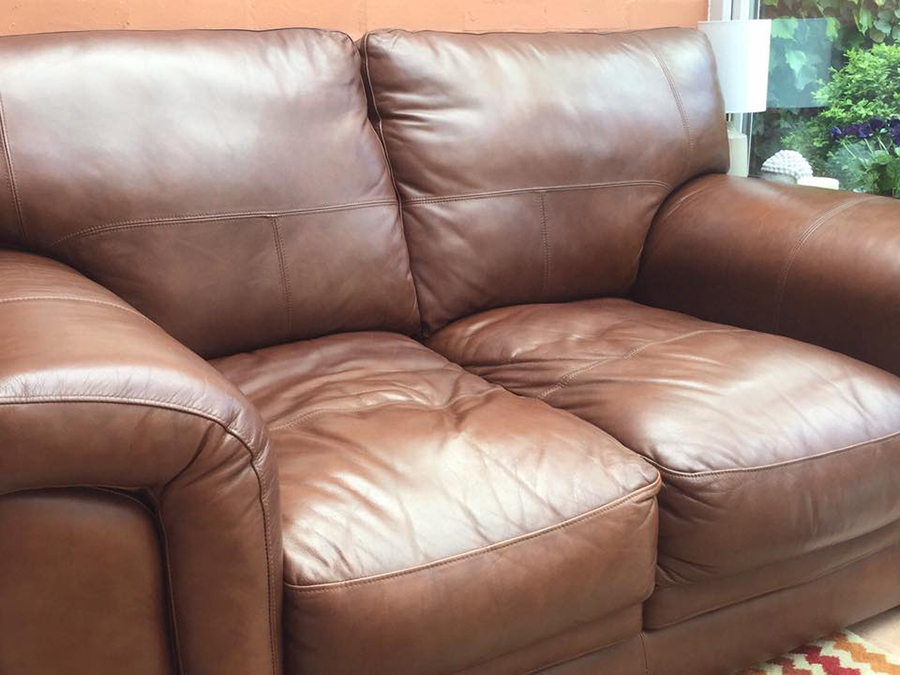The leather sofa, a staple of many homes, exudes an air of sophistication and comfort. However, over time, discoloration can mar its pristine appearance. Whether from spills, sunlight exposure, or general wear, these unsightly blemishes can diminish the aesthetic appeal of your beloved sofa.

Image: arthatravel.com
Identifying the Cause of Discoloration
Before embarking on a restoration mission, it’s essential to ascertain the root cause of the discoloration. This will guide your approach and ensure effective treatment. Common culprits include:
- Spills: Accidental spills of coffee, wine, or ink can leave behind unsightly stains.
- Sunlight exposure: Prolonged exposure to sunlight can cause leather to fade or develop sunspots.
- Body oils and sweat: Natural oils from the human body can build up on leather surfaces, leading to discoloration.
- Chemical exposure: Harsh cleaning agents or solvents can damage leather, causing discoloration.
Cleaning and Conditioning: The First Step
Before attempting to remove discoloration, thoroughly clean the leather sofa using a mild soap solution and a soft cloth. This removes dirt and grime, ensuring the treatment penetrates the leather effectively. Follow up with a leather conditioner to replenish its natural oils and enhance its protective barrier.
針對不同污漬的針對性解決方案
Once the sofa is clean and conditioned, it’s time to tackle the discoloration. Here are targeted solutions based on the underlying cause:
- Spills: Use a clean, absorbent cloth to blot up the spill immediately. Avoid rubbing, as this can spread the stain. Contact a professional cleaner for deep-set stains.
- Sunlight exposure: Regularly rotate the sofa to prevent uneven fading. If sun damage has occurred, consider using a leather dye to restore the color.
- Body oils and sweat: Mix equal parts white vinegar and water in a spray bottle. Spray lightly on the discolored area and wipe with a clean cloth. Repeat as needed.
- Chemical exposure: Seek professional help to neutralize the chemical and restore the leather’s condition.

Image: www.pinterest.com
Expert Tips and Advice
For optimal results, follow these expert recommendations:
- Test in an inconspicuous area: Always test any cleaning solution on a small, hidden area of the sofa to ensure it doesn’t damage the leather.
- Use a gentle touch: Avoid scrubbing or using harsh materials, as these can damage the leather’s surface.
- Avoid abrasive cleaners: Stick to mild soaps, leather cleaners, and natural solutions to prevent stripping the leather of its natural oils.
- Condition regularly: Regular conditioning maintains the leather’s suppleness and prevents discoloration.
常見問題解答
Q: Can I use bleach to remove discoloration?
A: No. Bleach is a harsh chemical that can damage leather and should never be used.
Q: How often should I condition my leather sofa?
A: It depends on the frequency of use and exposure to elements. As a general rule, condition every 3-6 months.
Q: Can I repair sun damage myself?
A: Superficial sun damage can be addressed with a leather dye. However, deep-seated damage may require professional restoration.
How To Fix Leather Sofa Discoloration
Conclusion
Restoring a discolored leather sofa requires a targeted approach and careful execution. By identifying the underlying cause and following the comprehensive guide outlined above, you can effectively restore your sofa’s pristine appearance and prolong its lifespan. Whether it’s a cherished heirloom or a modern masterpiece, remember to care for your leather sofa with love and attention, and it will continue to grace your home for years to come.
Are you passionate about maintaining your leather furniture in optimal condition? Share your tips and experiences in the comments section below!